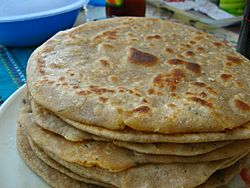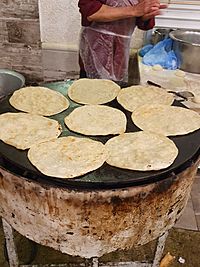Paratha facts for kids

|
|
| Place of origin | Indian subcontinent |
|---|---|
| Region or state | Indian subcontinent, Southeast Asia and Caribbean |
| Associated national cuisine | Bangladesh, Fiji, Guyana, India, Malaysia, Maldives, Myanmar, Nepal, Pakistan, Singapore, Sri Lanka, Suriname, Trinidad and Tobago |
| Main ingredients | Atta, ghee/butter/cooking oil and various stuffings |
| Variations | Aloo paratha, Roti Canai, Wrap roti |
A Paratha (say "puh-RAH-thah") is a yummy flatbread from South Asia. It's popular in many countries like India, Pakistan, Bangladesh, Sri Lanka, and Nepal. You can also find it in places like Malaysia, Singapore, and even the Caribbean!
The word Paratha comes from two words: parat and atta. This means "layers of cooked dough". It's usually made from wheat flour, which is a common food in these regions. People call it by different names, like parantha, porota, roti canai, or buss-up shut.
Contents
A Look Back: Paratha's History
The word paratha comes from an old language called Sanskrit. It means "layered" or "placed on top."
Historians believe that parathas were enjoyed by important people in the Punjab region of India a long time ago. This was between the years 1000 and 1526 AD.
Some people think parathas might be related to another dish called puran poli. Parathas became very popular in eastern India during the Mughal Empire. This led to the creation of the Dhakai paratha, which is a flaky, layered type named after Dhaka in Bangladesh.
How Parathas are Made
Parathas are one of the most loved flatbreads in the Indian subcontinent. They are made from whole-wheat dough. First, the dough is cooked on a flat pan called a tava. Then, it's finished by shallow-frying it with a little oil or ghee (a type of clarified butter).
Parathas are usually thicker than other flatbreads like chapatis. This is because they are often made with layers. To create layers, the dough is coated with ghee or oil and folded many times. This is similar to how puff pastry is made.
Sometimes, ingredients like mashed potatoes, cauliflower, or other vegetables are mixed right into the dough. This makes the paratha even more filling!
Plain and Stuffed Parathas
Parathas can be plain or stuffed.
- Plain parathas are made by layering the dough. They can be round, square, or even triangular.
- Stuffed parathas have a delicious filling inside. The most common stuffing is spiced mashed potatoes, called aloo paratha. Other popular fillings include lentils (dal), radishes, cauliflower, or paneer (a type of cheese).
To make a stuffed paratha, a ball of filling is placed inside a single piece of dough. The dough is then sealed around the filling and gently flattened before being rolled into a circle.
How to Enjoy Parathas
Parathas are a great choice for breakfast or as a snack. They are traditionally made with ghee, but oil is also used. Some people even bake them for a healthier option.
Parathas are often served with a dollop of white butter on top. They taste great with:
Some people like to roll their paratha into a tube and dip it in tea!
Different Kinds of Paratha
There are many delicious types of parathas, each with its own special twist:
- Aloo paratha: Stuffed with spicy boiled potatoes and onions.
- Chili paratha: Made with small, spicy shredded pieces.
- Gobi paratha: Stuffed with flavorful cauliflower.
- Mughlai paratha: A deep-fried paratha from Bangladesh and West Bengal, filled with egg and minced meat.
- Murthal Paratha: A deep-fried type famous in Haryana, India.
- Roti prata: A popular version found in Singapore.
- Roti canai: The Malaysian version of this flatbread.
- Buss-up-shut: From Trinidad, its name means "busted-up shirt" because of how the shredded bread looks!
Images for kids
-
Punjabi Aloo Paratha served with Butter, from India
-
Trinidadian-style roti paratha (buss-up shut)
-
In Myanmar, paratha is commonly eaten as a dessert, sprinkled with sugar
See also
 In Spanish: Paratha para niños
In Spanish: Paratha para niños












